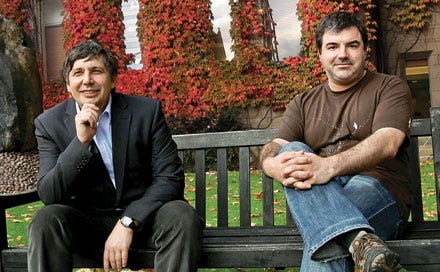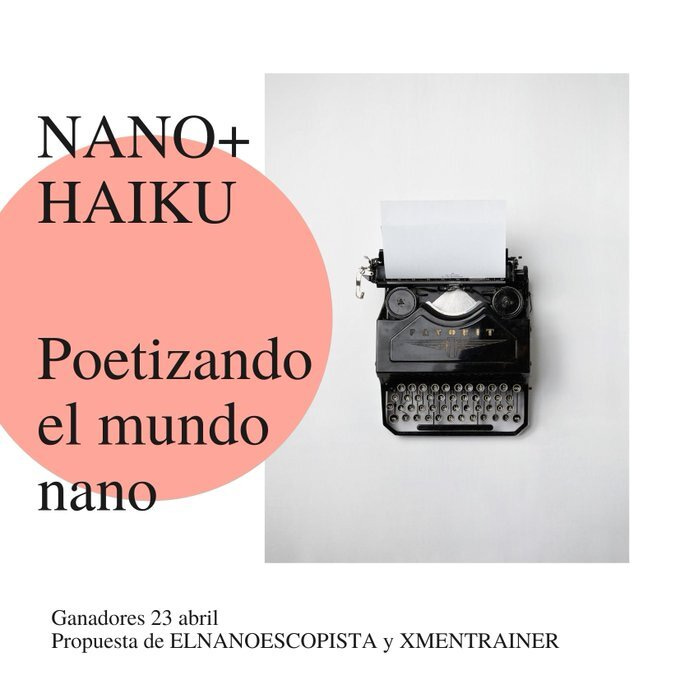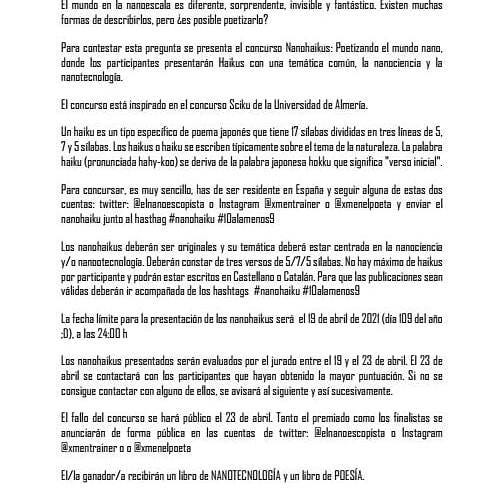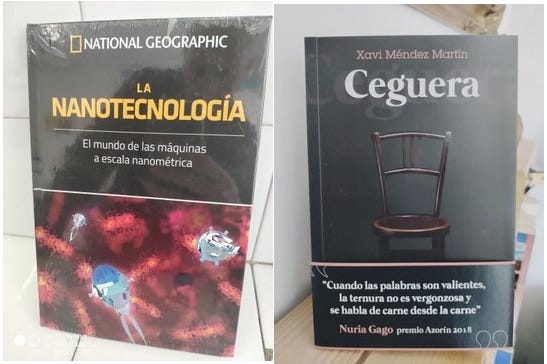Andre Geim, Konstantin Novoselov and their collaborators from the University of Manchester (UK), and the Institute for Microelectronics Technology in Chernogolovka (Russia), presented their results on graphene structures in October of 2004, in a paper that described the fabrication, identification and Atomic Force Microscopy (AFM) characterization of graphene. They used a simple mechanical exfoliation method for extracting thin layers of graphite from a graphite crystal with scotch tape and then transferred these layers to a silicon substrate. Furthermore, they managed to pattern samples containing only a few layers of graphene into a Hall bar and connect electrodes to it.
It was during the TNT2010 conference (September 06-10, 2010) that I met Andre Geim. I remember when he walked past me to pick up his badge and conference material and he told me how much he liked the chosen venue. We were at the INL (Braga, Portugal). This is the Spanish-Portuguese research centre on nanotechnologies.
Andre Geim was coming to the conference to present his talk entitled: “Graphene: Status and Prospects” The reader will find a short summary of that lecture
Graphene – a free-standing atomic plane of graphite – has turned out to be a wonder material. It has already attracted many superlatives to its name. It is of course the thinnest material in the universe and arguably the strongest one ever measured. Its charge carriers exhibit the highest known intrinsic mobility, have zero effective mass and can travel micron distances without scattering at room temperature. Graphene can sustain current densities million times higher than that of copper, shows record thermal conductivity and stiffness, is impermeable to gases and reconciles such conflicting qualities as brittleness and ductility. Electron transport in graphene and its bilayer is described by massless and massive Dirac-like equations, respectively (rather than the standard Schrodinger equation), which allows the investigation of relativistic quantum phenomena in a bench-top experiment. This will be a general talk for non-specialists introducing graphene and its fascinating properties [1]. For illustration, I will try using the results obtained by our team in Manchester during the last year or two. The new results include electron transport at the vicinity of the Dirac point in many-millionmobility devices, properties of the first stoichiometric derivative (fluorographene) and evidence for magnetic edges
My relationship with Konstantin Novoselov was very different because I don't remember meeting him at a conference, or at least I don't remember it, but he was my "boss" as he was one of the founders of the company Phasevents located in Singapore. My contacts with him were limited to a few e-mail exchanges during that time.
A month later it was announced that Andre Geim and Konstantin Novoselov received the Nobel Prize in Physics (2010)
Video Courtesy: Cambrigde University- Short film produced by the European Graphene-Flagship initiative, introducing graphene, the 'wonder substance' set to revolutionise the electronics industry.
What are we talking about when we name “Graphene”?
Graphene is a two-dimensional sheet of densely packed carbon atoms arranged in a single layer. Its structure resembles a crystal honeycomb lattice or chicken wire fence of sorts. Graphene is a considerably large aromatic molecule in the flat polycyclic aromatic hydrocarbon family. It is made up of numerous carbon allotropes, like graphite, carbon nanotubes, and other fullerenes. In this blog we will discuss a bit more on the history of this fascinating material.
Single layers of graphite could only be observed in bulk materials via transmission microscopy, particularly in soot retrieved through chemical exfoliation at this point. Several attempts were made to create thin films of graphite by mechanical exfoliation, starting in 1990 and continuing into 2004, but the thinnest sheets made consisted of 50-100 layers. Although the results of these attempts did not produce graphene, the material gained considerable interest, and success in creating graphene as we know it today would come a short time later.In 1947, the existence of graphene was theorized by Philip R Wallace as an attempt to understand electronic properties of 3D graphite. He did not use the term “graphene”, but instead referred to it as a “single hexagonal layer.” Beginning in the 1970s single layers of graphite were grown epitaxially on other materials, creating a kind of “epitaxial graphene,” or free-standing graphene, a hexagonal lattice consisting of single-atom-thick bonded carbon atoms. The term “graphene” appeared for the first time in 1987 and was used to describe individual graphite sheets as one component of graphite intercalation compounds, or GICs (crystalline salts of intercalant and graphene). At this time, “graphene” was also used to describe carbon nanotubes, epitaxial graphene, and polycyclic aromatic hydrocarbons.
Chemical Discovery
In 2004, a Manchester group, led by Andre Geim, unexpectedly extracted single-atom-thick-crystallites from graphite. This ultimately proved the existence of true 2D crystals, such as graphene, which was at this point widely considered not able to exist in a flat state.
This discovery of graphene met skepticism until 2005, when the findings of Geim’s group were supported by that of another group helmed by Philip Kim at Columbia University. Kim’s group published an article in an issue of Nature stating that the findings of both groups proved beyond a reasonable doubt that the graphite layers they obtained exhibited the electronic properties described in Wallace’s theory from almost six decades prior.
The main protagonists : Andre Geim & Konstantin Novoselov
Prof. Sir Andre Geim is Regius Professor at the University of Manchester. He was awarded the 2010 Nobel Prize for his groundbreaking work on graphene. He has also received numerous international awards and distinctions, including medals from the Royal Society and the US National Academy of Sciences, and holds honorary doctorates and professorships from many countries and universities. Thomson-Reuters repeatedly named him among the world’s most active scientists and attributed to him three new research fronts – diamagnetic levitation, gecko tape and graphene. More than thirty of his papers have been cited >1,000 times with six of them >10,000 times. He was awarded the 2000 Ig Nobel prize for his work on levitation, becoming the first and only recipient of both Nobel and Ig Nobel Prizes.
Prof. Sir Konstantin Novoselov was born in Russia in August 1974. He is best known for isolating graphene at The University of Manchester in 2004, and is an expert in condensed matter physics, mesoscopic physics and nanotechnology. He was awarded the Nobel Prize for Physics in 2010 for his achievements with graphene. Kostya is Langworthy Professor of Physics and Royal Society Research Professor at The University of Manchester.
He graduated from The Moscow Institute of Physics and Technology and undertook his PhD studies at The University of Nijmegen in the Netherlands before moving to The University of Manchester in 2001. Professor Novoselov has published more than 250 peer-reviewed research papers.
He has been awarded with numerous prizes, including the Nicholas Kurti Prize (2007), International Union of Pure and Applied Science Prize (2008), MIT Technology Review young innovator (2008), Europhysics Prize (2008), Bragg Lecture Prize from the Union of Crystallography (2011), the Kohn Award Lecture (2012), Leverhulme Medal from the Royal Society (2013), Onsager medal (2014), Carbon medal (2016) and Dalton medal (2016), among many others.
Don't hesitate to subscribe if you haven't already done so.
Regards and take care.
New contest: Poetry, haikus and NANOTECHNOLOGY
Join in as we combine the art of poetry with the beauty of science! Anyone can submit original haikus featuring their favorite science topic.
To participate send a haiku to @elnanoescopista (twitter) or @xmentrainer (instagram). The rules (below in Spanish):
The challenge is to describe nanotechnology in the form of a haiku.
Your submission should be posted before 19 April, 23.59
Your haiku should be a brief three-line poem in Spanish. Please note that we are not purists when it comes to the right number of syllables, etc.;
To take part, you don’t have to be a scientist – you just have to feel a personal connection to science & Poetry. So, students are welcome, engineers are welcome, scientific librarians are welcome, science journalists are welcome, etc.
Every individual contestant can submit multiple haikus. Every poem will then be treated as a single submission.
Two prizes (books) will be awarded: a) Nanotecnología: El mundo de las máquinas a escala nano (nanoscience) and Ceguera (Poetry)
Submitted haikus will be published in @elnanoescopista (twitter) or @xmentrainer (instagram) media channels. The copyright is your own, and we will not claim any intellectual ownership.
Questions?
Please contact jordinano@gmail.com
If you are a company or an individual who would like to place your advertising in my newsletter you can contact me (email) and let me know your request of type of ad and number of newsletters you would like to place it. I will send you a budget as soon as possible.












